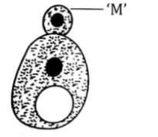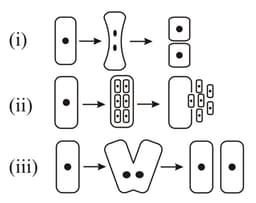Plasmotomy occurs in
Important Questions on Reproductive System
(i) During favourable conditions Paramecium stops feeding after attaining its maximum growth.
(ii) At first the micronucleus divides by amitosis and the macronucleus divides into two daughter nuclei by mitosis.
(iii) The proter receives the anterior contractile vacuole, cytopharynx and cytostome from its parent individuals.
(iv) Before karyokinesis a transverse constriction appears in the middle of the body.
Statement I: The binary fission of Euglena is called homothetogenic fission because the daughter euglenae are like mirror images.
Statement II: Binary fission in Paramecium is known as perkinetal fission because it occurs at right angles to the kineties.
Identify the asexual reproductive structure in the following diagram:

Match the following
| List-I | List-II | ||
| (A) | Longitudinal binary fission | (I) | Paramoecium |
| (B) | Transverse binary fission | (II) | Amoeba |
| (C) | Sporogony | (III) | Pleurobrachia |
| (D) | Sporulation | (IV) | Plasmodium |
| (V) | Euglena |
Transverse binary fission occurs in
Read the following statements and choose the correct statements:
A. Acellular protists like sporozoans (e.g., Monocystis, Plasmodium, etc.) exhibit sporulation in their life cycles.
B. In Hydra, the external bud does not get separated from the mother and form a colony.
C. In freshwater sponges like Spongilla, each gemmule gives rise to several offspring.
D. Genetically identical offspring resulting from a single parent are considered clones
Explain with examples types of asexual reproduction in unicellular organism.


